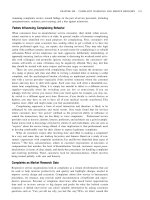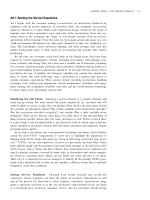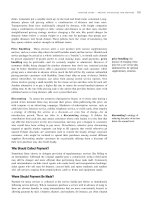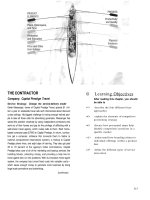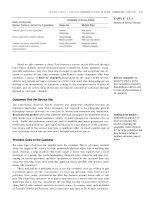Principles of Therfnal Analysis and Calorymentry
Bạn đang xem bản rút gọn của tài liệu. Xem và tải ngay bản đầy đủ của tài liệu tại đây (18.05 MB, 238 trang )
www.pdfgrip.com
www.pdfgrip.com
PRINCIPLES OF THERMAL
ANALYSIS AND CALORIMETRY
www.pdfgrip.com
RSC Paperbacks
RSC Paperbacks are a series of inexpensive texts suitable for teachers and students and
give a clear, readable introduction to selected topics in chemistry. They should also
appeal to the general chemist. For further information on all available titles contact:
Sales and Customer Care Department, Royal Society of Chemistry,
Thomas Graham House, Science Park, Milton Road, Cambridge CB4 OWF, UK
Telephone: +44 (0)1223 432360; Fax: + 44 (0)1223423429; E-mail: sales + rsc.org
Recent Titles Available
The Chemistry of Fragrances
compiled by David Pybus and Charles Sell
Polymers and the Environment
by Gerald Scott
Brewing
by Ian S. Hornsey
The Chemistry of Fireworks
b y Michael S. Russell
Water (Second Edition): A Matrix of Life
by Felix Franks
The Science of Chocolate
by Stephen T. Beckett
The Science of Sugar Confectionery
by W. P. Edwards
Colour Chemistry
by R . M . Christie
Understanding Batteries
by Ronald M . Dell and David A. 1.Rand
Principles of Thermal Analysis and Calorimetry
Edited by P. J . Haines
Future titles may be obtained immediately on publication by placing a standing order
for RSC Paperbacks. Information on this is available from the address above.
www.pdfgrip.com
RSC Paperbacks
PRINCIPLES OF THERMAL
ANALYSIS AND CALORIMETRY
Edited by P. J. Haines
Oakland Analytical Services, Farnhurn,
Surrey, U K
Contributors
G. R. Heal
University of Sdford, U K
P. G. Laye
University of Huddersfield, U K
D. M. Price
Loughborough University, U K
S. B.Warrington
Loughborough University, U K
R.J. Wilson
GlaxoSrnithKline, Harlow, U K
RSC
ROYAL SOCIETY OF CHEMISTRY
www.pdfgrip.com
ISBN 0-85404-610-0
A catalogue record for this book is available from the British Library
0The Royal Society of Chemistry 2002
All rights reserved.
Apart from any fair dealing for the purpose of research or private study, or
criticism or review as permitted under the terms of the U K Copyright, Designs and
Patents Act, 1988, this publication may not be reproduced, stored or transmitted,
in any form or by any means, without the prior permission in writing of The Royal
Society of Chemistry, or in the case of reprographic reproduction only in
accordance with the terms of the licenses issued by the Copyright Licensing
Agency in the U K , or in accordance with the terms of the licences issued by the
appropriate Reproduction Rights Organization outside the U K . Enquiries concerning
reproduction outside the terms stated here should be sent to The Royal
Society of Chemistry at the address printed on this page.
Published by The Royal Society of Chemistry,
Thomas Graham House, Science Park, Milton Road,
Cambridge CB4 OWF, UK
Registered Charity Number 207890
For further information see our web site at www.rsc.org
Typeset in Great Britain by Vision Typesetting, Manchester, UK
Printed in Great Britain by TJ International Ltd, Padstow, Cornwall
www.pdfgrip.com
Foreword
The Thermal Methods Group of the Royal Society of Chemistry, which
was founded in 1965, has a tradition of education in thermal analysis
dating back to its first residential thermal analysis school held at the
Cement and Concrete Research Association in 1968. The Group has
continued to be at the forefront of thermal education through the organisation of schools, specialist meetings and both national and international conferences.
Over the past twenty years, thermal methods have seen a rapid growth
in their use in an increasingly wide range of applications. In addition, a
number of powerful new techniques have been developed recently. It is
therefore timely that a group of UK scientists have pooled their specialist
expertise to produce this wide-ranging book, which should be of considerable value to those who are new to the field or who are coming to a
particular technique for the first time. The broad range of techniques and
applications covered means that there is also much to interest the more
experienced thermal analyst.
Throughout most of its long life the Thermal Methods Group has been
fortunate in having an outstanding contribution from three of its
members, namely Professor David Dollimore (Chairman 1969-1 97 l),
Dr Cyril J. Keattch (Hon. Secretary 1965-1998) and Dr Robert C.
Mackenzie (Chairman 1965-1967). These scientists throughout their long
and distinguished careers were unstinting in helping young workers and
those new to the field to develop their thermal analysis expertise. It is a
most fitting tribute that this book is dedicated to their memory and to
their invaluable contribution to the development of thermal analysis.
Edward L. Charsley
Pust President of the International Confederation
for Thermal Analysis and Calorimetry, ( I C T A C )
Centrefor Thermal Studies, University of Huddersfield, U K
V
www.pdfgrip.com
Dedicated to the memory of
Dr Cyril Jack Keattch,
1928-1999
Honorary Secretary of the Thermal Methods Group
for its first 33 years
Dr Robert Cameron Mackenzie
1920-2000
Founder Member of the TNIG (Chairman 1965-1967) and ICTAC
Professor David Dollimore
1927-2000
Chairman of the TMG 1969-1971
C. J. Keattch
R. C. Mackenzie
D. Dollimore
www.pdfgrip.com
Contents
Chapter I
Introduction
P. J. Haines
1
Materials, Heat and Changes
Definitions of Thermal and Calorimetric Methods
The Family of Thermal Methods
Instrumentation for Thermal Analysis and Calorimetry
The Reasons for Using Thermal and Calorimetric Methods
The Need for Proper Practice
Further Reading
References
Chapter 2
Thermogravimetry and Derivative Thermogravimetry
G. R. Heal
Introduction and Definitions
Instrumentation
Balance
Furnace
Atmosphere Control
Crucibles
Thermocouples
Temperature Control
Data Collection
Isothermal Experiments
Calibration for Mass and Temperature
Effect of Experimental Variables
Reporting Thermogravimetry Results
A. Properties of the Sample
B. Experimental Conditions
vii
10
10
12
12
14
15
15
16
16
17
18
19
20
24
24
24
www.pdfgrip.com
...
Vlll
C. Data Acquisition and Manipulation Methods
D. Results
A Typical Thermogravimetric Experiment
Preliminary Steps
Crucible Treatment
Zero Setting
Adding the Sample
Starting the Run
Ending the Run
Example Experiment
Results
Applications
Oxysalt Decomposition
Polymer Stability and Charcoal Production
Metal Oxidation
Compositional Analysis
Glass-making Reactions
Kinetics of Solid-state Reactions
Ancillary Techniques
Residue Analysis
Other Temperature Regimes
High Resolution Thermogravimetry
Further Reading
References
Contents
24
25
26
26
26
27
28
28
28
29
29
31
31
33
37
38
40
42
50
50
51
51
52
53
Chapter 3
Differential Thermal Analysis and Differential Scanning Calorimetry 55
P. G. Laye
Introduction
Definitions and Nomenclature
Applications
Theoretical Considerations
Instrumentation
Specification
Temperature Sensors
Crucibles
Temperature and Atmosphere Control
Cooling Systems and Accessories
Calvet-type Equipment
Experimental Considerations
Variables
55
57
60
65
69
69
69
70
70
71
71
72
72
www.pdfgrip.com
Contents
Do’s and Do not’s
Reference
Calibration
Preliminaries
Temperature Calibration
Energy Calibration
Measurements
Measurement of Heat Capacity
Measurement of Energy
Measurement of Purity
Kinetics
Final Thoughts on Measurement
Further Reading
References
Chapter 4
Thermomechanical, Dynamic Mechanical and Dielectric Methods
D. M . Price
Introduction and Principles
Thermomechanical Analysis and Thermodilatometry
Dynamic Mechanical Analysis
Dielectric Techniques
Instrumentation
Thermomechanical Analysis
Dynamic Mechanical Analysis
Dielectric Techniques
Typical Experiments
Thermomechanical Analysis
Dynamic Mechanical Analysis
Dielectric Techniques
Applications
Thermomechanical Analysis
Dynamic Mechanical Analysis
Dielectric Thermal Analysis
Modulated Temperature Thermomechanical and Dielectric
Techniques
Concluding Remarks
Acknowledgements
Further Reading
References
1x
73
75
76
76
77
79
82
82
85
87
89
91
91
92
94
94
94
96
99
101
101
103
105
106
107
109
113
117
117
120
123
126
126
127
127
127
www.pdfgrip.com
Contents
X
Chapter 5
Calorimetry
R. J . WiEEson
Introduction
Definition of Calorimetry
Thermochemistry and Thermodynamics
The First law of Thermodynamics
The Second Law of Thermodynamics
The Third Law of Thermodynamics
Calorimeters
Classification of Calorimeters
Calibration
Instrumentation: Calorimeters for Special Purposes
Solution Calorimeters
Combustion Calorimeters
Reaction Hazard Calorimeters
Isothermal Calorimeters
Applications of Isothermal Calorimetry
Calorimetric Information
The Calorimetric Signal
Reaction Mechanism
Kinetic Information
Examples of Calorimetric Applications
Chemical Reactions
Physical Changes
Summary
Acknowledgements
References
Chapter 6
Simultaneous Thermal Analysis Techniques
S. B. Warrington
Introduction: The Rationale behind the Simultaneous Approach
Simultaneous Thermogravimetry-Differential Thermal Analysis
(TG-DTA)
Instrumentation
Applications of TG-DTA
Simultaneous Thermogravimetry-Differential Scanning
C a1orimet r y (TG-DSC )
Instrumentation
129
129
130
131
132
133
133
136
137
138
139
139
141
144
145
146
148
148
150
152
153
153
156
160
161
161
166
166
167
167
170
172
172
www.pdfgrip.com
Contents
Applications of TG-DSC
Evolved Gas Analysis (EGA)
Introduction
Instrumentation for EGA
Applications of EGA
Less Common Techniques
Optical Techniques
Spectroscopic Techniques
X-Ray Techniques
DTA-Rheometry
Micro-thermal Analysis (p-TA)
Summary
References
Appendices
1.A Symbols for Physical Quantities and Units
Nomenclature for Thermal Analysis and Calorimetry
1.B Sources of Information
1.B.1 Journals
l.B.2 Major Textbooks on Thermal Analysis and
Calorimetry
l.B.3 Videos, CD-Roms etc.
1.B.4 Conference Proceedings
2
ICTAC and Its Affiliated Societies in Europe and
the USA
American and Other Standard Test Methods
3
3.1 American Society for Testing and Materials
(ASTM) Methods
3.2 British Standards
4
Manufacturers, Consultants and Other Suppliers
Consultancies and Other Groups
5
Subject Index
xi
173
174
174
175
177
181
181
183
183
185
185
187
187
190
190
191
191
191
192
197
197
199
200
201
205
207
214
216
www.pdfgrip.com
Acknowledgements
The authors of this text acknowledge their debt to Cyril Keattch, Robert
Mackenzie and David Dollimore.
It is also a pleasure to acknowledge the contribution made by the
instrument manufacturers over many years. They are listed in the Appendices, and the brochures, application notes and personal help which they
have given, and continue to give, plays a vital part in the use of thermal
and calorimetric analysis. The Group gratefully acknowledges their permission to use several of the diagrams in this text.
The Thermal Methods Group maintains a web site, through the Royal
Society of Chemistry at and a list
server whereby requests for information and queries about techniques
may be exchanged. If you wish to join the T M G Internet Newsgroup,
please follow the intructions on the TMG web site.
Thanks are due to many people, particularly Dr Trevor Lever and
Dr Michael Richardson for their help in preparing this book.
Peter J . Haines (Editor)
xii
www.pdfgrip.com
Contributors
P. J. Haines, Oakland Analytical Services, 38 Oakland Avenue, Farnham,
Surrey GU9 9 D X , U K
G. R. Heal, Department of Chemistry and Applied Chemistry, University of
SaEford, SaEford M5 4 WT, U K
P. G. Laye, Centre for Thermal Studies, University of Huddersjield,
Queensgate, Huddersjield H D l 3DH, U K
D. M. Price, Institute of Polymer Technology and Materials Engineering,
Loughborough University, Loughborough LEI 1 3 T U , U K
S. B. Warrington, Institute of Polymer Technology and Materials Engineering, Loughborough University, Loughborough LEI 1 3 T U , U K
R. J. Willson, GEaxoSmithKline, New Frontiers Science Park (South),
Harlow, Essex CM19 5AW, U K
...
XI11
www.pdfgrip.com
www.pdfgrip.com
Chapter 1
Introduction
P. J. Haines
Oakland Analytical Services, Farnham, U K
MATERIALS, HEAT AND CHANGES
Whenever a sample of material is to be studied, one of the easiest tests to
perform is to heat it. The observation of the behaviour of the sample and
the quantitative measurement of the changes on heating can yield a great
deal of useful information on the nature of the material.
In the simplest case, the temperature of the sample may increase,
without any change of form or chemical reaction taking place. In short, it
gets hotter. For many other materials, the behaviour is more complex.
When ice is heated, it melts at 0°C and then boils at 100°C.When sugar is
heated, it melts, and then forms brown caramel. Heating coal produces
inflammable gases, tars and coke. The list is endless, since every material
behaves in a characteristic way when heated.
Thermal methods of analysis have developed out of the scientific study
of the changes in the properties of a sample which occur on heating.
Calorimetric methods measure heat changes.
Some sample properties may be obvious to the analyst, such as colour,
shape and dimensions or may be measured easily, such as mass, density
and mechanical strength. There are also properties which depend on the
bonding, molecular structure and nature of the material. These include
the thermodynamic properties such as heat capacity, enthalpy and entropy and also the structural and molecular properties which determine
the X-ray diffraction and spectrometric behaviour.
Transformations which change the materials in a system will alter one
or more of these properties. The change may be physical such as melting,
crystalline transition or vaporisation or it may be chemical involving a
1
www.pdfgrip.com
2
Chapter 1
reaction which alters the chemical structure of the material. Even biological processes such as metabolism, interaction or decomposition may be
included.
Sometimes a change brought about by heating may be reversed by
cooling a sample afterwards. A pure organic substance melts sharply, for
example benzoic acid melts at 122°C and it recrystallises sharply when
cooled below this temperature. Ammonium chloride dissociates into
ammonia and hydrogen chloride gases when heated, but these recombine
on cooling. At high temperature, calcium carbonate splits up to yield
calcium oxide and carbon dioxide gas, and these too will recombine on
cooling if the carbon dioxide is not removed. The system reaches an
equilibrium state at a particular temperature.
heat
CaCO, (solid) A CaO (solid) + CO, (gas)
cool
7
To raise the temperature of any system heat energy must be supplied
and when sufficient energy is available the system will change into a more
stable state. The mechanical properties of a material change as it is
heated. Often it expands and becomes more pliable well below the
melting point. These are fundamental, important changes on a molecular
level, and their study enables the analyst to draw valuable conclusions
about the sample, its previous history, its preparation, chemical nature
and the likely behaviour during its proposed use.
The temperature at which a particular event occurs, or the temperature
range over which a reaction happens, are often characteristic of the
nature and history of a sample, and sometimes of the methods used to
study it. Sharp transitions, such as the melting of pure materials, may be
used to calibrate equipment and as the "fixed points" of thermometry and
of the International Practical Temperature Scale (IPTS).
For example, how does the simple, pure inorganic compound potassium nitrate, K N 0 3 , behave when heated? At room temperature, say
20°C, this is a white, crystalline solid. To raise its temperature to 30°C at
constant presssure, we must supply an amount of heat depending on the
specific heat capacity, C,, approximately 1 J K-' g-' at this temperature,
the mass w1 of the sample and the change in temperature. So, for 1 g heated
10°C, we must supply 1OJ. To complicate matters, the heat capacity
changes with temperature as well. When the temperature reaches 128"C,
the crystals change their structure, and this needs more energy, about
53 J g-'. Then the new crystals are heated, when C, w 1.2 J K-' g-', until
the melting point of 338"C, when more heat must be supplied to melt the
sample. Raising the temperature above the melting point eventually
www.pdfgrip.com
Introduction
3
causes the sample to decompose to form potassium nitrite, K N 0 2 ,so that
the mass of the sample is decreased by around 16% and oxygen gas is
given off.
This example illustrates the importance of thermal techniques and
measurements. Calorimetry measures the amounts of heat, while appropriate thermal methods give the temperatures of phase changes, the
temperatures of decomposition and the products of the reaction. Other
methods will show the expansion, mass and colour changes on heating.
The analysis of thermal events may be approached in two ways, which
overlap considerably. Either the experiment may be designed to measure
thermal properties (heat capacity, enthalpy, entropy and free energy) with
high precision and accuracy at particular temperatures and conditions, or
we may study properties, including thermal properties, over a wider
range of temperatures using a controlled heating procedure.
Which experiment is chosen depends on the sample to be analysed.
There would be little point in obtaining highly accurate heat capacities on
a polymeric or cement sample of complex composition, but its behaviour
on heating would be informative. Theoretical work on organic structure
and kinetics might require precise knowledge of equilibrium thermal
properties which could not easily be obtained using variable temperature
methods. Therefore, the techniques are complementary.
Since the worldwide adoption of the SI system of units it is perhaps
useful to stress the symbols and units to be used for the physical quantities involved in these methods. The major quantities are given in Appendix 1A and the others may be found in the references.’, 2
DEFINITIONS OF THERMAL AND CALORIMETRIC
METHODS
Formal definitions are not essential, but those accepted by the scientific
community may be found in the l i t e r a t ~ r e . ~ ’ ~
Calorimetry is the measurement of the heat changes which occur
during a process. The calorimetric experiment is conducted under particular, controlled conditions, for example, either at constant volume in a
bomb calorimeter or at constant temperature in an isothermal
calorimeter. Calorimetry encompasses a very large variety of techniques,
including titration, flow, reaction and sorption, and is used to study
reactions of all sorts of materials from pyrotechnics to pharmaceuticals.
Calorimetric methods may be classified either by the principle of
measurement (e.g. heat compensating or heat accumulating), or by the
method of operation (static, flow or scanning) or by the construction
principle (single or twin cell). These will be discussed further in Chapter 5.
www.pdfgrip.com
4
Chapter 1
Thermal anaEysis is a group of techniques in which one (or more)
property of a sample is studied while the sample is subjected to a controlled temperature programme. The programme may take many forms:
(a) The sample may be subjected to a constant heating (or cooling) rate
(dT/dt = p), for example 10 K min-’.
(b) The sample may be held isothermally (p = 0).
(c) A “modulated temperature programme” may be used where a
sinusoidal or other alteration is superimposed onto the underlying
heating rate.
(d) To simulate special industrial or other processes, a stepwise or
complex programme may be used. For example, the sample might
be equilibrated at 25°C for 10 min, heated at 10 K min-’ up to
2OO0C,
held there for 30 min and then cooled at 5 K min-l to 50°C.
(e) The heating may be controlled by the response of the sample itself.
THE FAMILY OF THERMAL METHODS
Every thermal method studies and measures a property as a function of
temperature. The properties studied may include almost every physical or
chemical property of the sample, or its products. The more frequently
used thermal analysis techniques are shown in Table 1 together with the
names most usually employed for them.
INSTRUMENTATION FOR THERMAL ANALYSIS
AND CALORIMETRY
The modern instrumentation used for any experiment in thermal analysis
or calorimetry is usually made up of four major parts:
The sample and a container or holder;
sensors to detect and measure a particular property of the sample
and to measure temperature;
an enclosure within which the experimental parameters (e.g. temperature, pressure, gas atmosphere) may be controlled;
a computer to control the experimental parameters, such as the
temperature programme, to collect the data from the sensors and to
process the data to produce meaningful results and records.
This is shown schematically in Figure 1, and specific applications and
instrumentation will be considered in the following chapters.
www.pdfgrip.com
5
Introduction
Table 1 Thermal methods
Technique
Abbreviation Property
Thermogravimetry or
(Thermogravimetric analysis)
Differential thermal analysis
TG
TGA
DTA
Differential scanning calorimetry DSC
Thermomechanical analysis
TMA
Dynamic mechanical analysis
DMA
Dielectric thermal analysis
Evolved gas analysis
DETA
EGA
Thermoptometry
Uses
Mass
Decompositions
Oxidations
Temperature
Phase changes,
difference
reactions
Power difference
Heat capacity,
or heat flow
phase changes,
reactions
Deformations
Mechanical
changes
Dimensional change Expansion
Moduli
Phase changes,
glass transitions,
polymer cure
Electrical
as DMA
Gases evolved
Decompositions
or reacted
Optical
Phase changes,
surface reactions,
colour changes
Less frequently used methods
Thermosonimetry
TS
Sound
Thermoluminescence
Thermomagnetometry
TL
TM
Light emitted
Magnetic
Mechanical and
chemical
changes
Oxidation
Magnetic
changes,
Curie points
Sensor( s)
Enclosure
Sample
-
Sensor( s)
for T etc.
Figure 1 Schematic of general thermal analysis or calorimetry apparatus
www.pdfgrip.com
6
Chapter 1
THE REASONS FOR USING THERMAL AND
CALORIMETRIC METHODS
Novice analysts may enquire why yet another technique is needed when
gas chromatography, molecular and atomic spectrometry and electrochemical analysis plus many other powerful analytical tools are available. The answer might best be given by considering two practical
examples.
First, how can you analyse a mixture of processed minerals such as a
cement? Although X-ray diffraction might tell you the different minerals
present and atomic absorption spectrometry could measure the elements
quantitatively, this does not help to analyse how the cement would
behave in practice. For this we need to compare the behaviour under
conditions of mechanical and thermal stress and the thermoanalytical
techniques of TG, DTA and TMA are important tools for doing t h i ~ . ~ ? ~
Second, the preparation of new chemicals for new pharmaceutical
products, synthetic materials and foods could add to the hazards which
workers and customers face. Thermal instability and explosive behaviour
can be extremely destructive and costly events. Reaction calorimetry and
similar techniques can help to predict the likely behaviour of chemicals
when reactions, transport and storage are concerned. Physiological
behaviour may vary with the nature and form of a drug, and the nature
and interconversion of these forms is often studied by thermal and
calorimetric methods.
Many analytical techniques require samples in a particular form. For
example, gas-liquid chromatography and mass spectrometry need volatile samples and UV-VIS spectrometry usually uses solutions. Therefore, in analysing we destroy the structure of the matrix containing the
sample. This has two disadvantages: (i) the behaviour of the sample in its
original matrix may be different and (ii) it is time-consuming to alter the
form. It is possible to use thermal methods to study the sample “as
received”. This avoids laborious preparation, does not change the thermal and molecular history of the sample and gives information to the
analyst about the real sample and how it would behave in the situation or
process where it is actually used.
7 9 8
THE NEED FOR PROPER PRACTICE
Some analytical techniques are sample specific. The “group frequency”
bands in an infrared spectrum are largely independent of the method used
to obtain the spectrum, whether it is run as a solid KBr disc, a Nujol mull
or a solution and whether it is obtained by a dispersive or a Fourier
www.pdfgrip.com
Introduction
7
transform instrument. Similarly the titration of an acid with a base should
give the same result whether the end-point is detected by an indicator or
electrochemically.
This is not always so in the case of thermal methods. The results
obtained depend upon the conditions used to prepare the sample, the
instrumental parameters selected for the run and the chemical reactions
involved. That is not to say that results are not reproducible provided
similar conditions are selected. For example, it is possible to compare
samples of a polymer to see if their behaviour is “good” or “bad” according to their potential use, but the experimental parameters used for
running each sample must be the same.
The useful acronym “SCRAM” (sample-crucible-rate of heatingatmosphere-mass) will enable the analyst to obtain good, reproducible
results for most thermal methods provided that the following details are
recorded for each run:9
The sample: A proper chemical description must be given together with
the source and pre-treatments. The history of the sample, impurities and
dilution with inert material can all affect results.
The crucible: The material and shape of the crucible or sample holder is
important. Deep crucibles may restrict gas flow more than flat, wide ones,
and platinum crucibles catalyse some reactions more than alumina ones.
The type of holder or clamping used for thermomechanical methods is
equally important. The make and type of instrument used should also be
recorded.
The rate of heating: This has most important effects. A very slow
heating rate will allow the reactions to come closer to equilibrium and
there will be less thermal lag in the apparatus. Conversely, high heating
rates will give a faster experiment, deviate more from equilibrium and
cause greater thermal lag. The parameters of special heating programmes, such as modulated temperature or sample control, must be
noted.
The atmosphere: Both the transfer of heat, the supply and removal of
gaseous reactants and the nature of the reactions which occur, or are
prevented, depend on the chemical nature of the atmosphere and its flow.
Oxidations will occur well in oxygen, less so in air and not at all in argon.
Product removal by a fairly rapid gas flow may prevent reverse reactions
occurring.
The mass of the sample: A large mass of sample will require more
energy, and heat transfer will be determined by sample mass and dimensions. These include the volume, packing, and particle size of the sample.
Fine powders react rapidly, lumps more slowly. Large samples may allow
the detection of small effects. Comparison of runs should preferably be
www.pdfgrip.com
8
Chapter 1
made using similar sample masses, sizes and shapes.
Specific techniques require the recording of other parameters, for
example the load on the sample in thermomechanical analysis.
Calorimetric methods, too, require attention to the exact details of each
experiment. In the following chapters the principles and practice of
thermal analysis and of calorimetry will be described and illustrated with
some of the many examples of its use in industry, academic research and
testing.
FURTHER READING
An extensive list of reference sources and specialist texts is given in
Appendix 1B. Some general texts which introduce thermal analysis and
calorimetry for analytical studies are listed here.
General Analytical Chemistry Books with Chapters on Thermal and
Calorimetric Methods
G. D. Christian and J. E. O’Reilly, Instrumental Analysis, Allyn & Bacon
Inc., Boston, 2nd edn., 1986.
F. W. Fifield and D. Kealey, Principles and Practice of Analytical Chemistry, Blackwells, Oxford, 5th edn., 2000.
R. Kellner, J-M. Mermet, M. Otto and H. M. Widmer (ed.), Analytical
Chemistry, Wiley-VCH, Weinheim & Chichester, 1998.
I. M. Kolthoff, P. J. Elving and C. B. Murphy (ed.), Treatise on Analytical
Chemistry, Part 1 , Theory and Practice (2nd edn.) Vol. 12, Section J , Wiley,
New York, 1983.
D. A. Skoog and J. L. Leary, Principles of Instrumental Analysis, Saunders, New York, 4th edn., 1992.
C. L. Wilson, D. W. Wilson (ed.), Comprehensive Analytical Chemistry,
Elsevier, Amsterdam, 1981-1984, Vol XIT, A-D.
J. D. Winefordner (ed.), Treatise on Analytical Chemistry, Wiley, New
York, 1993, Part 1, Vol. 13.
R. A. Meyers (ed.), Encyclopedia of Analytical Chemistry, Wiley, Chichester, 2000.
REFERENCES
1. Quantities, Units and Symbols, Royal Society, London, 1971.
2. I. Mills, T. Cvitas, K. Homann, N. Kallay and K. Kuchitsu, Quantities, Units and Symbols in Physical Chemistry, IUPAC, Blackwell,
Oxford, 1993.
www.pdfgrip.com
Introduction
9
3. R. C. Mackenzie, in Treatise on Analytical Chemistry, ed. 1. M.
Kolthoff, P. J. Elving and C. B. Murphy, Part 1, Theory and Practice
(2nd edn.), Vol. 12, Section J , Wiley, New York, 1983, pp. 1-16.
4. W. Hemminger and S. M. Sarge, Handbook of Thermal Analysis and
Calorimetry, ed. M. E. Brown, Elsevier, Amsterdam, 1998, Vol. 1, Ch.
1.
5. Recommendations for the Testing of High Alumina Cement Concrete
by Thermal Techniques, Thermal Methods Group, London, 1975.
6. H. G. Wiedemann and M. Roessler, in Proc. 7th ICTA, ed. B. Miller,
Wiley, Chichester, 1982, p. 1318.
7. U. von Stockara and I. Marison, Thermochim. Acta, 1991,193,215.
8. M. Angberg, C. Nystrom and S. Cantesson, Int. J . Pharm., 1990,61,
67.
9. P. J. Haines, Thermal Methods of Analysis, Blackie, Glasgow, 1995.



